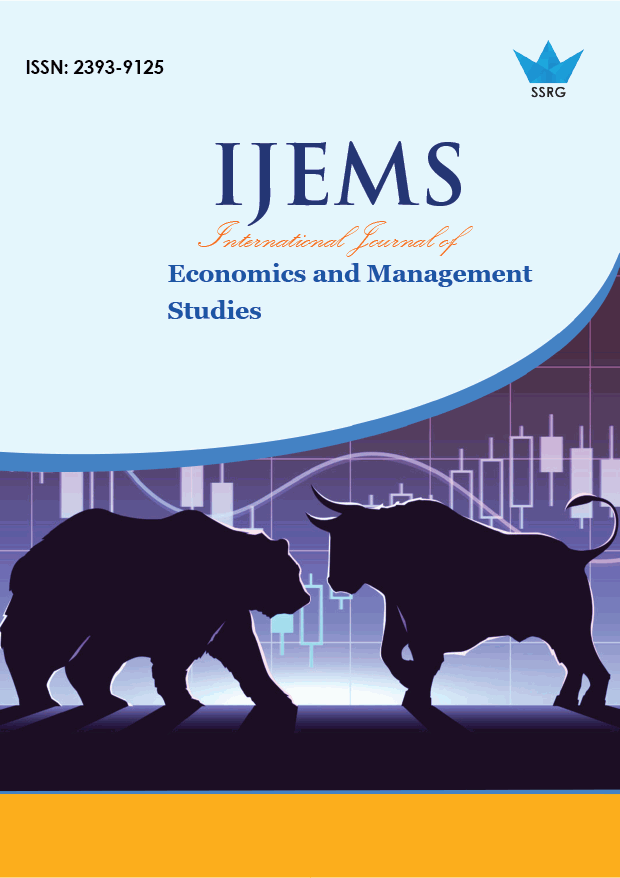Energy Consumption, Industrial Production and CO2 Emissions in Two Major African Countries

| International Journal of Economics and Management Studies |
| © 2020 by SSRG - IJEMS Journal |
| Volume 7 Issue 2 |
| Year of Publication : 2020 |
| Authors : Victor Okechukwu Nwatu |
How to Cite?
Victor Okechukwu Nwatu, "Energy Consumption, Industrial Production and CO2 Emissions in Two Major African Countries," SSRG International Journal of Economics and Management Studies, vol. 7, no. 2, pp. 177-185, 2020. Crossref, https://doi.org/10.14445/23939125/IJEMS-V7I2P126
Abstract:
This paper estimates the relationship between energy consumption, carbon (iv) oxide emission, and industrial production for Nigeria and South Africa. The usual preliminary analysis and formal tests were performed on the data before the Autoregressive Distributed Lag (ARDL) were applied in the model estimation. The choice of the ARDL was due to the results obtained from the formal tests, especially the unit root tests. The model estimation for the data took into account the need to lag the data to be able to achieve stationary property. Both short-run and long-run estimates were generated. Diagnostic tests were also carried out on the estimated models. The results coefficients for energy consumption and carbon (iv) oxide emission were obtained for the short and long run for Nigeria and for only the short-run for South Africa. Conclusions and policy recommendations were then made to the government in line with the results of the model estimation. Top of the list is the regulation of energy consumption and carbon footprint via policies in the effort to increase industrial production.
Keywords:
CO2, Energy Consumption, GDP, Policy, ARDL.
References:
[1] Abimelech, G. P., Zhen, W., Presley, W., & Isaac, R. Y., The impacts of oil price shocks on small oil-importing economies: Times series evidence for Liberia. Energy, (2017) 975-990.
[2] Alkhathlan, K., & Javid, M. (2013, November). Energy consumption, carbon emissions and economic growth in Saudi Arabia: An aggregate and disaggregate analysis. Energy Policy, (2013) 1525-1532.
[3] Ang, J. B.., CO2 emissions, energy consumption, and output in France. Energy Policy 35( 8) (2007).
[4] Bernard, O. A., & Oludare, A. (2016). is energy consumption relevant to industrial output in NIGERIA? European Journal of Research in Social Sciences, 14 (2016).
[5] Bowden, N., & Payne, J. E, The causal relationship between U.S. energy consumption and real output: A disaggregated analysis. Journal of Policy Modeling, 31(2) (2009) 180-188.
[6] Chindo, S., Abdulrahim, A., Waziri, I. S., Huong, M. W., & Ahmad, A. A., Energy consumption, CO2 emissions, and GDP in Nigeria. GeoJournal, 9 (2014).
[7] Edenhofer, O., Pichs-Madruga, R., & Sokona, Y. .,Climate Change 2014 Mitigation of Climate Change. Intergovernmental Panel on Climate Change. Cambridge: Cambridge University Press, (2014).
[8] EIA. (2019). eia Beta. Retrieved February 25, 2019, from International Energy Statistics: https://www.eia.gov/beta/international/data/browser/#/?pa=0000000g&c=00000000000000000000000000000004&ct=0&tl_id=3002-A&vs=INTL.26-2-NGA-BCF.A&vo=0&v=H&end=2017
[9] Ezenwa, E. N., & Nwatu, V. O., The Effect of Natural Gas Utilization and CO2 Emissions on the Economic Growth of Nigeria. SSRG International Journal of Economics and Management Studies (SSRG-IJEMS), (2020) 1 - 8.
[10] Gambo, S. L., Binti, S. I., Ismail, N. W., & Idris, M. M., Energy Consumption, Environmental Emissions, and Economic Growth: An Empirical Analysis in Nigeria. Journal Of Humanities And Social Science(2279-0837), (2018) 11-22.
[11] Ilhan, O., & Ali, A, CO2 emissions, energy consumption, and economic growth in Turkey. Renewable and Sustainable energy reviews, 14(9) (2010) 3220-3225.
[12] Kaygusuz, K., Energy and Environmental Issues Relating to Greenhouse Gas Emissions for Sustainable Development in Turkey. Renewable and Sustainable energy reviews, 13(1) (2009) 253-270
[13] Kutu, A. A., & Ngalawa, H.,Dynamics of Industrial Production in BRICS Countries. International Journal of Economics and Finance Studies, (2016) 1-8.
[14] Kutu, A. A., & Ngalawa, H., MONETARY POLICY AND INDUSTRIAL OUTPUT IN THE BRICS COUNTRIES: A MARKOV-SWITCHING MODEL. Folia Oeconomica Stetinensia, (2017)1 - 21.
[15] Lemazoshvili, B. (2014, November 23). Effect of Oil Price Shocks on Oil Importing Developing Economies: The Case of Georgia and Armenia. Economic Education and Research Consortium, (2014) 1-28.
[16] Nwatu, V. O., & Ezenwa, N. (2020, January). Natural Gas Consumption, Economic Growth and CO2 Emission Relationships in Nigeria. International Journal of Scientific & Engineering Research, 11(1) (2020) 226 - 260.
[17] Sohag, K., Mamun, M. A., Uddi, G. S., & Mohamed, A. M., Sectoral output, energy use, and CO2 emission. Environ Sci Pollut Res, (2017) 11.
[18] US Energy Information Administration Website. .,Primary Energy COnsumtion. Retrieved 08 09, 2018, from IEA: https://www.eia.gov/beta/international/data/browser/#/?pa=000000001s&c=000000000000000000000000000000040000000000000000002&ct=0&vs=INTL.44-2-NGA-QBTU.A&vo=0&v=H&end=2015
[19] World Economic Outlook. (2017, 04). World Economic and Financial Surveys. Retrieved 02 24, 2018, from International Monetary Fund: https://www.imf.org/external/pubs/ft/weo/2017/01/weodata/index.aspx

 10.14445/23939125/IJEMS-V7I2P126
10.14445/23939125/IJEMS-V7I2P126